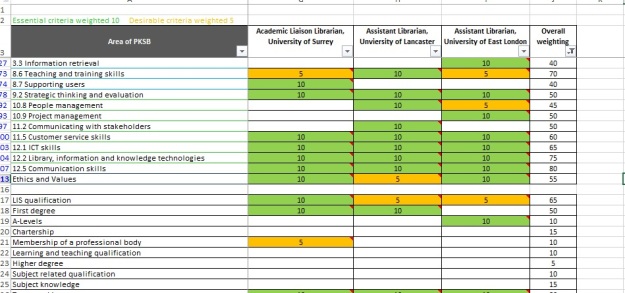A couple of weeks ago I took part in my first Chartership chat where a couple of people asked for advice on tackling the PKSB. Like them, I too was initially daunted by its size and the language it uses so I thought I’d share my strategy for rationalising and demystifying the PKSB in the hope that it might prove useful to others.
On my first attempt to tackle it I spent an inordinate amount of time wading through the full version of the PKSB and looking up lots of unfamiliar terms in various dictionaries and glossaries. This left me feeling I knew even less about my profession than I did to begin with and that I had more gaps in my knowledge and skills than I could ever hope to tackle. After a couple more equally disheartening attempts I decided to take a more pragmatic approach.
Before registering for Chartership I’d spent some time looking at job descriptions and person specifications for the types of posts I’d eventually like to move into so it made sense to use these in conjunction with the PKSB to help me pinpoint the areas I need to develop in order to take the next step in my career.
To do this I downloaded the gap analysis spreadsheet from CILIP’s VLE and, keeping the PKSB areas with their pop-up descriptions in the first column, added columns for my current position and each of the posts I’d looked at. I then matched the selection criteria from the person specifications with the corresponding areas of the PKSB.
Although this proved pretty time consuming to begin with, it helped me to translate the PKSB into more familiar language and develop a clearer understanding of the different areas without having to wade through the full version several times. Any selection criteria which didn’t match the PKSB exactly I either put against an area that made the most sense to me (e.g. time management isn’t specifically mentioned in the PKSB so I matched it with project management) or added it to the bottom of the spreadsheet (e.g. specified qualifications). To remind me why I’d matched each of the selection criteria to a particular area I added the text from the person specification as a comment. This made it easier to go back and rematch it against a more relevant area as my overall familiarity and understanding of the PKSB developed. The resulting spreadsheet allowed me to see at a glance which areas are relevant to me and my current career aspirations and those which I can, for the time being at least, safely disregard. Although this helped to reduce the PKSB to a more manageable size, I was still left with more than 6-10 potential areas to cover.
To narrow them down further, I first weighted the essential and desirable selection criteria for each post by adding a score of 10 or 5 respectively. By calculating a total for each of the PKSB areas I could then apply a filter to limit the spreadsheet to those over a particular score (in my case 40) to start identifying priority areas for development. I then downloaded another copy of the gap analysis spreadsheet which, having already used it for the job analysis, I was able to complete very quickly to assess myself against all the PKSB areas.
Using these two spreadsheets I was able to come up with a shortlist of PKSB areas to consider. These were all areas where the difference between my current and ideal self-assessment score was -1 or below. Some were priorities identified by the filtered job analysis spreadsheet and others, such as strategic management, were areas of particular interest and/or those I thought would help me with forthcoming projects in my current role. From this shortlist I was then able to select the 6-10 PKSB areas to focus on developing for Chartership confident that I’ll be concentrating my efforts in the right areas to progress my career.
I appreciate that the above approach may appear a bit convoluted but it helped me to break tackling the PKSB into smaller, less scary steps, and has given me a method I can use at future points in my career to review my professional development. Although it might not work for everyone reading this post I hope that sharing my experience will offer some encouragement and reassurance to others currently struggling to get to grips with the PKSB and will help them to find their own way of making it work for them.



